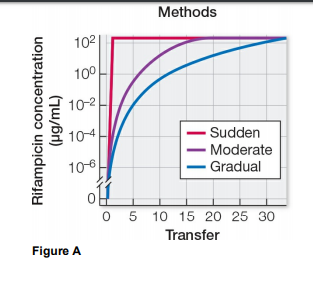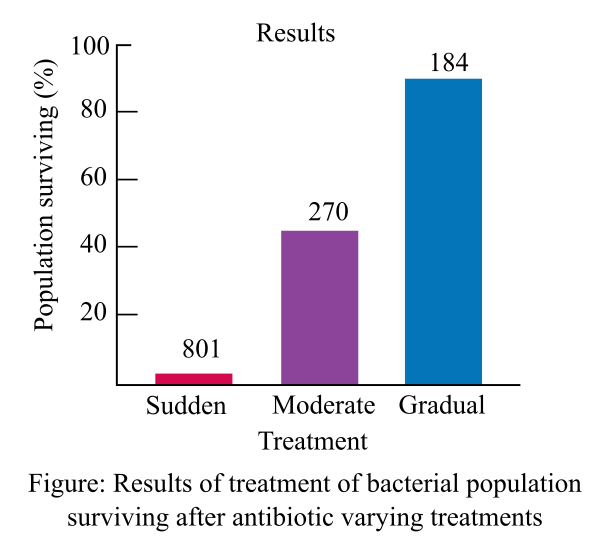
Concept explainers
To analyze:
The results of the investigation showing the relationship between gradual and sudden environmental changes on the extinction, evolution, and adaptation of the populations.
Given:
Overuse of drugs has been associated with the significant increase in drug-resistance. In the given experiment, the researchers use a serial transfer for propagating 1,255 population of Escherichia coli in gradually increasing antibiotic (rifampicin) concentration environment.

Figure A shows the increasing rifampicin concentrations which are increased suddenly, gradually and moderately.

In the figure B the results of the experiments depicting the percentage of population surviving the antibiotic conditions are shown.
Introduction:
Extinction of the organisms is by the fact of sudden changes which occur in ecosystem. Sudden changes do not allow the organism to adapt and acclimatize to the environmental conditions. Gradual changes allow the organism to get accustomed to the changes and allow it to adapt accordingly.
Explanation of Solution
The experiment involved the exposure of antibiotic to the bacteria, by two ways one gradual other sudden. Survival population after treatment with different antibiotic concentrations at different rates differed greatly.
It is very much clear from survival population numbers in the graph that a sudden increase leads to the death because of such sudden increase in antibiotic concentration.
In the case of gradual increase the bacteria survived eventually end up becoming antibiotic resistant because of the fact that the gradual increase allowed the bacteria to save and protect itself by acquiring plasmids, point mutations, and genetic recombination.
The less time in sudden increase in antibiotics made the bacterium incapable of genetic exchange and hence the bacterial population decreased in numbers considerably.
The above experiment can explain the adaptation in case of multidrug resistant (MDR) and extensively drug resistant (XDR) species of Mycobacterium tuberculosis as well as sudden extinction of dinosaurs.
Therefore, it can be concluded that the extinction and loss of organisms is due to sudden change in environmental factors whereas acclimatization is the result of gradual changes in the environmental conditions.
Want to see more full solutions like this?
Chapter 1 Solutions
LIFE:SCIENCE OF BIOL.(LL) >CUSTOM<
- Reactunts C6H12O6 (Glucose) + 2NAD+ + 2ADP 2 Pyruvic acid + 2NADH + 2ATP a. Which of the above are the reactants? b. Which of the above are the products? c. Which reactant is the electron donor? GHz 06 (glucose) d. Which reactant is the electron acceptor? NAD e. Which of the products have been reduced? NADH f. Which of the products have been oxidized? g. Which process was used to produce the ATP? h. Where was the energy initially in this chemical reaction and where is it now that it is finished? i. Where was the carbon initially in this chemical reaction and where is it now that it is finished? j. Where were the electrons initially in this chemical reaction and where is it now that it is finished? 3arrow_forwardThere is ________ the concept of global warming. Very strong evidence to support Some strong evidence to support Evidence both supporting and against Evidence againstarrow_forwardHow many types of reactions can an enzyme perform?arrow_forward
- Your goal is to produce black seeds resistant to mold. So you make the same cross again (between a homozygous black seeded, mold susceptible parent and a homozygous white seeded and mold resistant parent), and, again, advance progeny by SSD to create 100 F10 generation plants. Based on the information you obtained from your first crossing experiment (Question #4), how many F10 plants would you expect to have black seeds and be resistant to mold? Assume that a toxin produced by the mold fungus has been isolated. Only mold resistant seeds will germinate in the presence of the toxin. Could you use this toxin screening procedure to have segregation distortion work in your favor in the F2 generation? Explain your answer. Info from Question 4 a. P Locus (Seed Color): Hypothesis: The null hypothesis (H₀) is that seed color is controlled by alleles at a single locus. Observed Data: Total white seeds: 45 (resistant plants) + 6 (susceptible plants) = 51 Total black seeds: 7 (resistant…arrow_forward10. Consider the following enzyme and its substrate where the "+" and "-" indicate cations and anions, respectively. Explain which of the following inhibitors could inhibit this enzyme? Which type of inhibitor would it be and why? (Video 5-2) Substrate Enzyme Potential inhibitorsarrow_forwardUsing Punnett Squares Punnett squares are one good way to predict the outcome of genetic crosses. Punnett squares use mathematical probability to help predict the genotype and phenotype combinations in genetic crosses. The number of possible alleles from each parent determines the number of rows and columns in the Punnett square. Independent Assortment KEY QUESTION How do alleles segregate when more than one gene is involved? Mendel wondered if the segregation of one pair of alleles affects another pair. For example, does the gene that determines the shape of a seed affect the gene for seed color? This type of experiment is known as a two-factor, or dihybrid, cross because it involves two different genes. Single-gene crosses are monohybrid crosses. Visual Reading Tool: Two-Factor Cross: F₂ The Punnett square shows the results of self-crossing the F, generation of a cross between round yellow peas and wrinkled green peas. 1. List the different genotypes in the F, generation. What is the…arrow_forward
- CHAPTER 12 LESSON 2 Applying Mendel's Principles READING TOOL Connect to Visuals Before you read, preview Figure 12-7. Try to infer the purpose of this diagram. As you read, compare your inference to the text. After you read, revise your statement if needed or write a new one about the diagram's purpose. Take notes on the lines provided. Then view the Punnett square and answer the questions below regarding the genotypes and phenotypes. Inference: Revision: Parent 2 rryy Gametes F ry Parent 1 RRYY Gametes RY RrYy The F, generation are all RrYy. 1. What is the phenotype of parent 1?. 2. What is the genotype of parent 1? 3. What is the phenotype of parent 2? 4. What is the genotype of parent 2? 5. What is the phenotype of the F, offspring?. 6. What is the genotype of the F, offspring?. 7. What kind of cross does this figure describe? 144 Chanter 12 Introduction to Genetice Copyright Pearson Education Inc. or its affiliator. All rights reserved.arrow_forwardHow is the term enzyme related to the term proteinarrow_forwardCan very low temperatures cause proteins to denature? Explain why or why not?arrow_forward
- Humans consider themselves amazingly clever and innovative, constantly developing "new" ways of altering the world around us. As material consumption has increased, many have turned to the ideas of recycling and reuse as a means to minimize some negative aspects of our modern consumerism. Mother Nature though is the ultimate innovator and, more importantly, the ultimate recycler.arrow_forwardH gene assorts independently from the I gene. Both on autosomes. One man and one woman, both of HhIAIB genotype. Determine the blood type of progeny and fractions out of 16arrow_forwardAlleles at the P locus control seed color. Plants which are pp have white seeds, white flowers and no pigment in vegetative parts. Plants which are P_ have black seeds, purple flowers and may have varying degrees of pigment on stems and leaves. Seed color can be assessed, visually, based on if the seed is white or not white A gene for mold resistance has been reported and we want to determine its inheritance and whether it is linked to P. For the purposes of this exercise, we will assume that resistance is controlled by a single locus M, and M_ plants are resistant and mm plants are susceptible. Resistance can be measured, under greenhouse conditions, 2 weeks after planting, by injecting each seedling with a spore suspension. After two weeks, the seedlings can be rated as resistant or susceptible, based on whether or not tissue is actively sporulating. For this exercise we will use seed and data from the F10 generation of a recombinant inbred population produced using single seed…arrow_forward
 Biology (MindTap Course List)BiologyISBN:9781337392938Author:Eldra Solomon, Charles Martin, Diana W. Martin, Linda R. BergPublisher:Cengage Learning
Biology (MindTap Course List)BiologyISBN:9781337392938Author:Eldra Solomon, Charles Martin, Diana W. Martin, Linda R. BergPublisher:Cengage Learning Concepts of BiologyBiologyISBN:9781938168116Author:Samantha Fowler, Rebecca Roush, James WisePublisher:OpenStax College
Concepts of BiologyBiologyISBN:9781938168116Author:Samantha Fowler, Rebecca Roush, James WisePublisher:OpenStax College Biology: The Dynamic Science (MindTap Course List)BiologyISBN:9781305389892Author:Peter J. Russell, Paul E. Hertz, Beverly McMillanPublisher:Cengage Learning
Biology: The Dynamic Science (MindTap Course List)BiologyISBN:9781305389892Author:Peter J. Russell, Paul E. Hertz, Beverly McMillanPublisher:Cengage Learning
 Biology 2eBiologyISBN:9781947172517Author:Matthew Douglas, Jung Choi, Mary Ann ClarkPublisher:OpenStax
Biology 2eBiologyISBN:9781947172517Author:Matthew Douglas, Jung Choi, Mary Ann ClarkPublisher:OpenStax Human Heredity: Principles and Issues (MindTap Co...BiologyISBN:9781305251052Author:Michael CummingsPublisher:Cengage Learning
Human Heredity: Principles and Issues (MindTap Co...BiologyISBN:9781305251052Author:Michael CummingsPublisher:Cengage Learning





